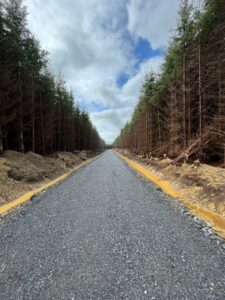Forest Roads
Forest roads are an integral part of Ireland’s forestry industry, offering access to woodland areas, facilitating timber harvesting, and ensuring the responsible management of forests. The process of constructing and maintaining these roads involves careful planning, adherence to environmental regulations, and often financial support through grants. This piece will explore the construction and grant process for forest roads in Ireland, shedding light on the steps involved and the importance of sustainable practices. Forest Road Procedure:- Planning and Design: The constructing of forest roads in Euroforest Ireland begins with meticulous planning and design from our road specialist Nicholas Butler. Forest owners collaborate with foresters and engineers to assess the necessity of a road and its ideal location, considering terrain, soil quality, drainage, and the preservation of sensitive ecosystems. This planning phase aims to minimize the environmental impact of the road.
- Environmental Impact Assessment: Prior to commencement, an environmental impact assessment (EIA) can be mandatory depending on environmental constraints on a site by site basis. This comprehensive evaluation assesses potential environmental effects, such as habitat disturbance, water quality, and wildlife impact. The EIA ensures the project complies with stringent environmental regulations and standards. We collaborate with our Ecologist Fergal Scully to carry these out to the highest standard.
- Obtaining Necessary Permissions: The construction of forest roads necessitates various permits and permissions, including single consents ( Engineer Reports), and, in some cases, permissions regarding Rights of ways. These permits are vital for ensuring compliance with legal and environmental requirements.
- Construction Phase: Once approved all planning and regulatory requirements are satisfied, the actual construction of the forest road can begin. The construction process entails clearing vegetation, grading the terrain, installing drainage structures (like culverts), and surfacing the road with appropriate materials. Particular attention is given to minimizing soil erosion and safeguarding nearby water bodies.
- Maintenance and Monitoring: Post-construction, forest roads demand consistent maintenance to ensure their longevity and minimize their environmental footprint. Regular monitoring is essential to identify and address any erosion, drainage, or vegetation issues promptly.
- Grant Application: Forest owners, often in collaboration with their forest advisors or consultants, can seek financial assistance for forest road construction through various grant programs. In Ireland, these grant programs are administered by the Department of Agriculture, Food, and the Marine (DAFM). The grant application typically encompasses project details, cost estimates, and alignment with forestry management plans. A forest owner is entitled to 25m of road grant for every hectare of forestry they own. The grant has recently been boosted from €40/m to €55/m.
- Eligibility: To qualify for grants, forest road projects must meet specific criteria, including a minimum forest area requirement and strict compliance with environmental regulations.
- Grant Approval: Following the submission of an application, DAFM reviews it to ensure it adheres to program guidelines. If approved, the forest owner receives financial support to cover a portion of the construction costs. Generally 70-80% of the overall costs.
- Construction and Inspection: Once grant approval is secured, the forest owner can proceed with road construction as per the approved plan. During and after construction, representatives from DAFM may conduct inspections to verify compliance with environmental regulations and grant terms.
- Grant Claim: Upon the completion of forest road construction, the forest owner must submit a grant claim to receive the allocated funding. This typically involves providing documentation of the project’s costs and confirming that all conditions have been met.


